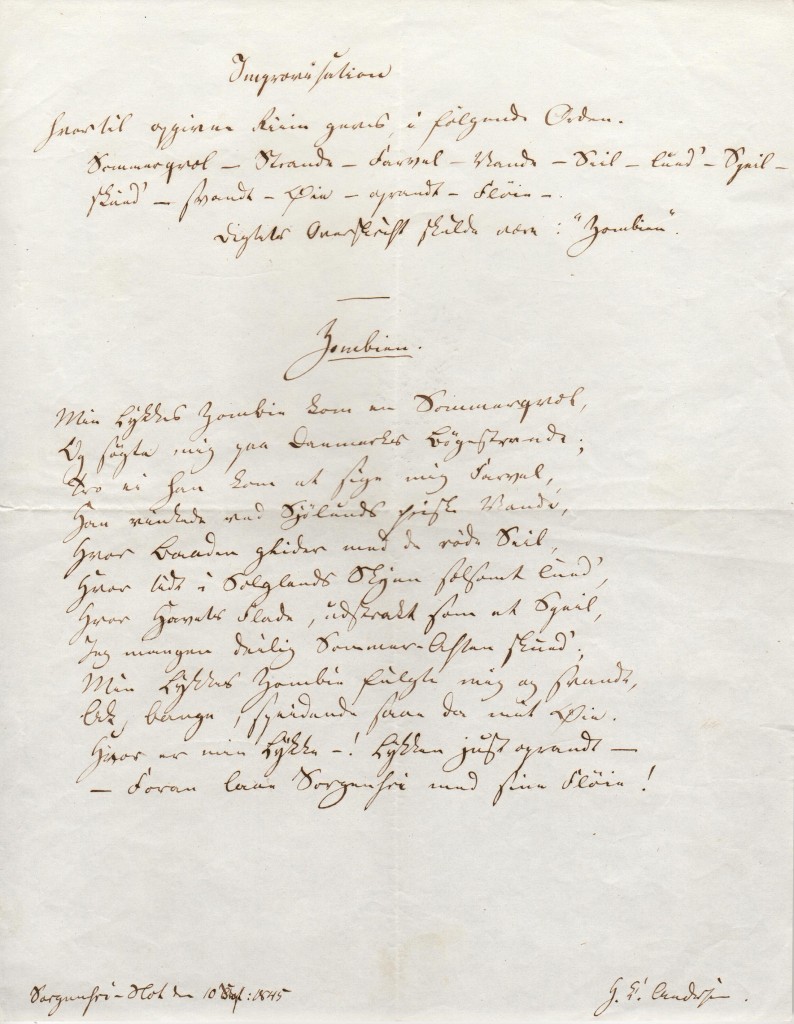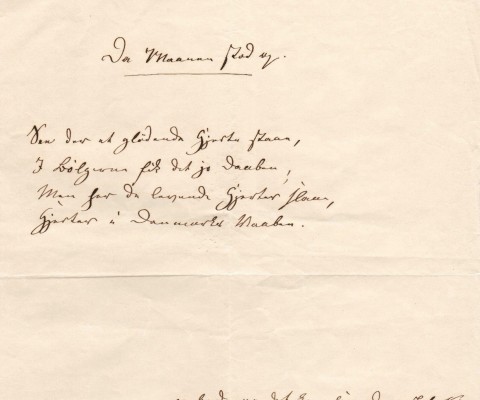Handwritten poems by Hans Christian Andersen from Queen Caroline Amalie’s Library
In Queen Caroline Amalie’s library a number of handwritten poems by prominent poets of the time have hidden amongst the many books. There are poems by Adam Oehlenschläger, B.S. Ingemann, Carsten Hauch, H.P. Holst and N.F.S. Grundtvig, and not least by Hans Christian Andersen.
The Queen was, as can be seen from her library, interested in contemporary literature and held, particularly after she was widowed, literary salons in Christian VIII’s Palace. On Tuesdays a small group of invited guests met for readings and discussion, and it was no doubt during these gatherings that a number of the poems found their way onto the shelves. Other poems are marked with a date and place, from which it can be seen that they were written at, for example, Sorgenfri Palace, where Christian VIII and Caroline Amalie also counted the cultural personalities of the age among their guests.
There are eight handwritten poems by Hans Christian Andersen in Queen Caroline Amalie’s library. Most have been printed, either in the poet’s own lifetime or in later editions of his works, diaries, and almanacs, but some are as yet unpublished. The majority stem from a stay with the royal family on the island of Föhr in 1844, with the queen’s brother the Duke of Augustenburg, while one stems from a trip on the steamship ‘Kiel’, which was the royal yacht of the time. Andersen entertained the company with improvisations composed off the top of his head, often on request.
One evening on the ship he improvised both a poem to the royal couple and one to the queen alone. The second improvisation was given the title ‘When the Moon Rose’:
See, there stands a glowing heart
It was baptized in the waves
But here the living hearts beat
Hearts in Denmark’s coat of arms

Hans Christian Andersen, ‘The Zombie’
The title ‘The Zombie’ probably surprises the contemporary reader – it doesn’t seem to fit the Golden Age, but rather contemporary horror films. The poem was written at Sorgenfri Palace in 1845, and has never been published.
It is the result of a test the party gave the poet, in which he was given a list of apparently random rhymes to improvise with, and had to be titled ‘The Zombie’. The party probably found this in his own poems, for in 1838 he had published a long poem with the title ‘The Zombie did it!’, which is about a black slave boy in the house of the Spanish painter Murillo, who turns out to be the greatest artist of them all – a variation on the theme of the ‘The Ugly Duckling’, one might say. The result of the improvisation with the random rhymes is not scary, accordingly, but more a letter of thanks to the royal hosts:
Improvisation
For which these rhymes were given in the following order:
Summer’s eve – Beaches – Goodbye – Waters – Sail – wood – Mirror-
Moment – vanished – Eye – dawned – Wings – .
The title of the poem should be: ‘The Zombie’.
The Zombie
My joy’s Zombie came one summer’s eve,
And sought me on Denmark’s beech-clad strands;
Think not he came to take his leave,
He waved by Zealand’s bracing beaches,
Where the boat glides with its sails red,
How oft in sunshine the cloud strangely blazed,
Where at the sea’s surface, like a mirror spread,
I many a lovely summer evening gazed,
My joy’s Zombie followed me and vanished,
Oh, afraid, my eye saw there espying.
Where is my joy – ! Joy just dawned –
-In front lay Sorgenfri with its wings!
Sorgenfri Palace, 10 Sept. 1845
H. C. Andersen
 Dansk
Dansk
 English
English
 Deutsch
Deutsch

